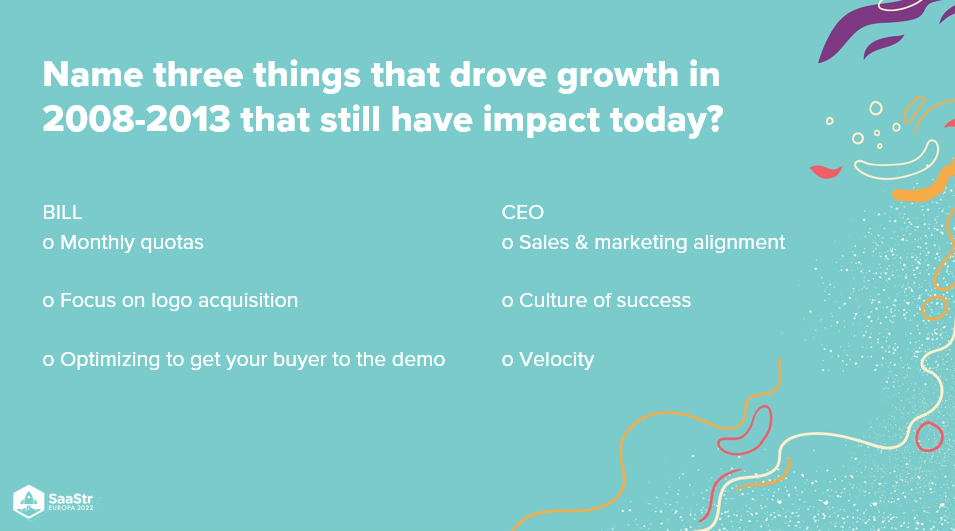A successful, growing business depends as much on its metrics as it does on its people. How can you focus your workforce and your data simultaneously?
Marketo’s and Pendo’s former EVP of Sales, Bill Binch, have had decades of experience tackling precisely these issues.
How to get CEOs and CROs on the same page
As an operating partner at a venture firm, Bill gets this question a lot. He suggests these five tactics for every company to consider:
- Conduct this thought experiment: Would you rather buy more logos with a smaller ACV or the other way around? Either individual answer can be correct, but the answer should be the same across your team.
- Score your deals. It doesn’t matter what metric you use, but look at your deals every month and decide whether they were good or bad. You want a shared vision of what your deals should look like in the future.
- Once a quarter, build your current org chart. Then build them one, two, or three quarters out. You want to demonstrate what you think the business will look like, and it can help you connect with how the business is evolving.
- Build bottom-up as much as you build top-down. Consider not only how many reps you have and how many you’ll hire, but also incorporate attrition and productivity metrics that give you insight into the health of your organization.
- If you don’t meet your quota, find out why. Was it because you didn’t have enough pipeline or didn’t convert at a normal rate? And consider doing this analysis monthly rather than saving it for the board meeting.
How to drive growth
“Think about what happens in the last few seconds of any tightly contested game. You see performance peak. You see people perform at their best.” – Bill Binch
Bill and Phil agree on a lot of things, but each has drawn different lessons from their own experience. For Bill, accelerating growth requires three things:
- Monthly quotas. Even if monthly quotas don’t seem to fit your business model, Bill would suggest it anyway. These regular metrics provide a cadence and pace to your organization, and those twelve viewpoints per year can prove invaluable.
- Focus on logo acquisition. Centering your work on customer experience helps train the whole organization in the process and hones your product-market fit.
- Optimizing to get your buyer to the demo. It can take a lot of time for a person to get as far as your demo. But they have always been, and will likely continue to be, the most likely buyers of your product.
Phil, meanwhile, has his own take:
- Sales and marketing alignment. Have your marketing and head of sales collaborate on their sales arc. As symbiotic as both these roles are, it’s critical to have them on the same page.
- Culture of success. You should always endeavor for greater success: if you meet your monthly quota, set the next one even higher. And then, if you fail to achieve those goals, stop and ask why.
- Velocity. Much like Bill’s quotas and logo acquisition, Phil argues that it’s essential to build repeatability into your organization.

Things that don’t work
Some moves that seemed critical just a few short years ago no longer work today. What should be avoided?
- Office-based model. In a world where talent is global, and work is remote, the office falls by the wayside. But don’t be dogmatic: remote-only may miss out on in-person skill-sharing, but requiring on-site work may drive away great talent.
- Enterprise/SDR. The buyer used to have to jump through hoops: interviews, qualifications, and customization. But B2B and PLG are much more streamlined, reducing friction for everyone involved.
- ABM. As you grow towards enterprise status, you may change your focus from inbound leads to accounts. But remember that ABM is not a technology but a process.
New product-led techniques that drive high-growth
“Imagine if you went to create a Facebook profile, and they said they’d get back to you in thirty days. That instant gratification from B2C now applies to us in B2B.” – Bill Binch
SaaS exists in an evolving world. What new tricks of the trade have appeared that can achieve your goals?
- Less human involvement. It no longer takes a human being eight hours to guide you through a demo. That reduces friction for everybody involved.
- User telemetry. You can now track users within the product, which helps inform its design. If most users only use 20% of the product, the rest is just upselling.
- Self-service model. Whereas SaaS used to require referrals to grow, self-service makes the product’s spread easier.
- Product tour. Websites and demos have always been helpful but limited. Product tours can tell the story of your product through the product itself, like a choose-your-own-adventure for the user.
- Calendars instead of forms. Who wants to fill out more forms? Allowing your user to schedule their demo lets them engage with the rep immediately and directly.
- Seminars. If you’re already doing over thirty demos in a week, consider a weekly live webinar. Your reps will thank you for saving their time and energy.
- Simplified user terms. The classic enterprise model used to have heavy, negotiated terms. But having industry-standard agreements saves time for everybody.

Key takeaways
It’s hard to summarize years of combined experience into succinct bullet points, but here is what Bill and Phil would encourage people to remember the most.
- NRR is the new magic metric. While 120% used to be considered best in the class, Bill wouldn’t be surprised if PLG organizations might see 200% (or more).
- Architect for growth path. Apply PLG inside your business; not everything needs to be a custom-made cycle.
- Velocity is everything. Whether through monthly quotas or focusing on logos, your business should work to ascend. Repeatability is key!

